 Neuerscheinungen 2017Stand: 2020-02-01 |
Schnellsuche
ISBN/Stichwort/Autor
|
Herderstraße 10
10625 Berlin
Tel.: 030 315 714 16
Fax 030 315 714 14
info@buchspektrum.de |

Lukas Rybok
Unsupervised object candidate discovery for activity recognition
2. Aufl. 2017. 208 S. 210 mm
Verlag/Jahr: EPUBLI 2017
ISBN: 3-7450-1072-8 (3745010728)
Neue ISBN: 978-3-7450-1072-5 (9783745010725)
Preis und Lieferzeit: Bitte klicken
The aim of this work is to explore ways how to boost video-based activity recognition performance by augmenting motion features with object information.
Object knowledge is an important cue to distinguish between human activities, but nevertheless usually disregarded in video-based activity recognition systems. In contrast, the aim of this work is to explore ways how to boost activity recognition performance by augmenting motion features with object information. Instead of relying on supervised detectors, the proposed object representation is motivated by a key mechanism of visual perception: saliency detection. Saliency detection serves as a gating mechanism selecting which information to process. It thus allows us, humans, to focus our visual attention on certain regions even before we identify them as actual objects. The proposed proto-object features are based on computational models implementing such an attentional process making the representation independent of statistical knowledge about objects. A major advantage of the present approach is, therefore, its ability to be transferred across domains without the explicit necessity of learning new object models.
Rybok, Lukas
Lukas Rybok has recently concluded his PhD studies in computer science at the Karlsruhe Institute of Technology (KIT). The focus of his research during his time at the KIT was automatic activity recognition from videos. Specifically, part of his work comprised the investigation of methods allowing to gain object knowledge without the need of explicitly trained detectors. He always has been fascinated in gaining the understanding of human perception and the computational modeling thereof. Thus, other than activity recognition, his general research interests include Computer Vision, Pattern Recognition, Machine Learning, Neural Computation, Data Mining, and Automatic Speech Recognition.


